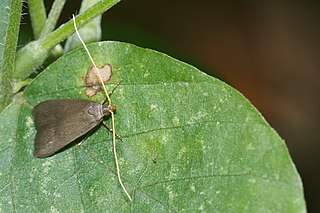
The Lecithocerinae are a subfamily of small moths in the family Lecithoceridae. They are found worldwide, but most species occur in South Asia. The subfamily is characterized by the male genitalia with a bridge-like structure connecting the tegumen and the valva, and the uncus almost always is vestigial with two lobes at the dorsal base, only exceptionally united into a broad plate, but never as a thorn or spine.

Eurodachtha is a genus of moths in the family Lecithoceridae.

Eurodachtha pallicornella is a moth in the family Lecithoceridae. It was described by Staudinger in 1859. It is found in France and on the Iberian Peninsula.
Eurodachtha siculella is a moth in the family Lecithoceridae. It was described by Wocke in 1889. It is found on the Iberian Peninsula and in France, as well as on Sicily.

Eurodachtha flavissimella is a moth in the family Lecithoceridae. It was described by Josef Johann Mann in 1862. It is found in Bulgaria, Greece and Spain. It is also found in Turkey.
Eurodachtha nigralba is a moth in the family Lecithoceridae. It was described by László Anthony Gozmány in 1978. It is found in Syria.
Eurodachtha rotundina is a moth in the family Lecithoceridae. It was described by Kyu-Tek Park in 2009. It is found in Thailand.


